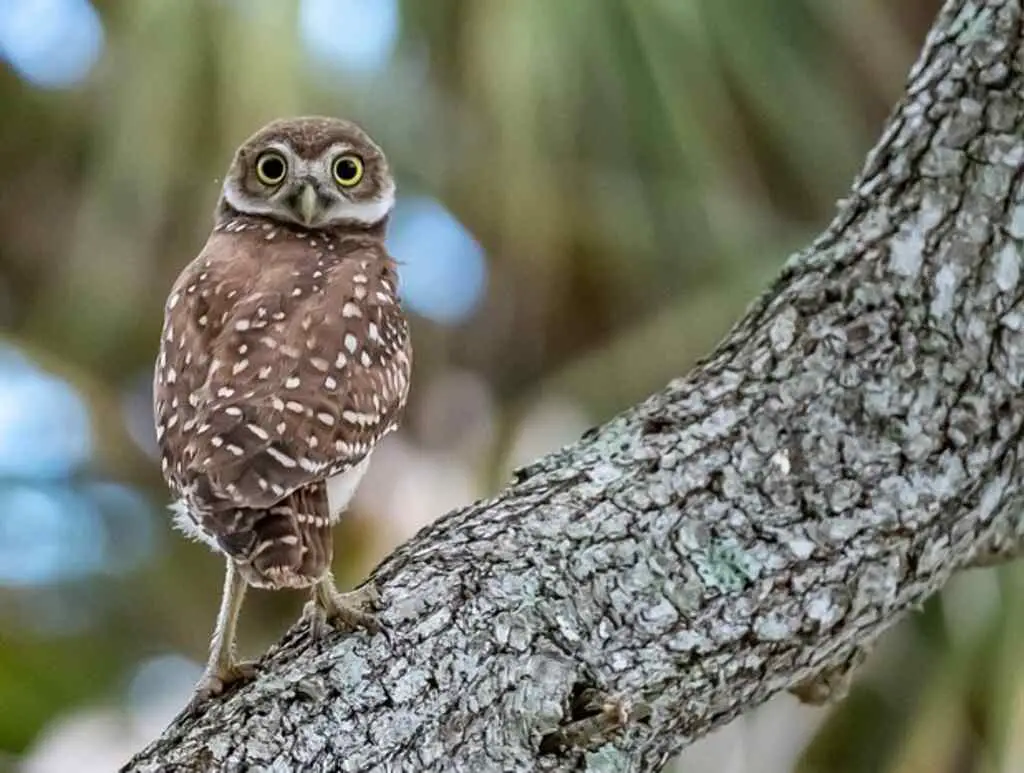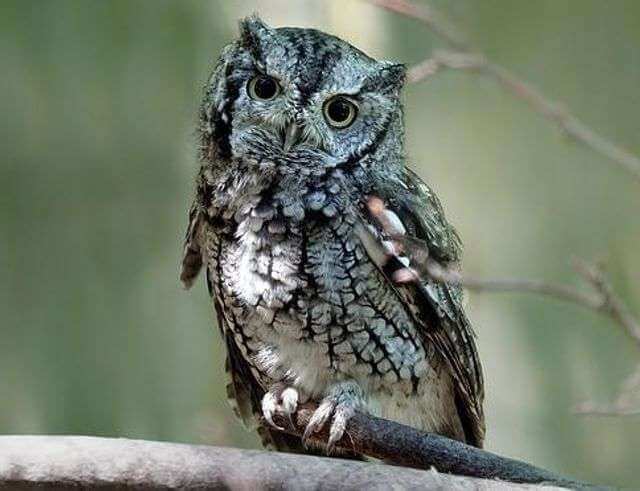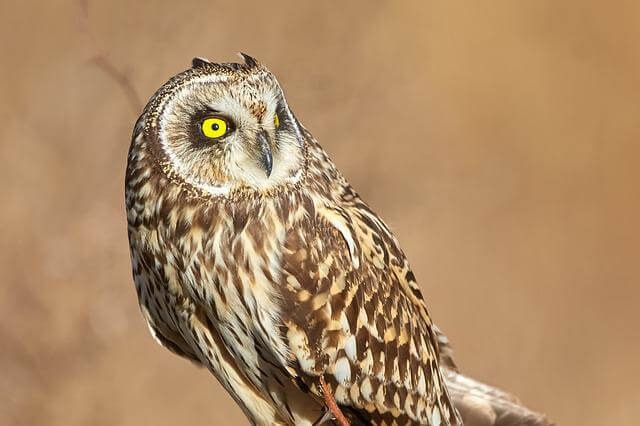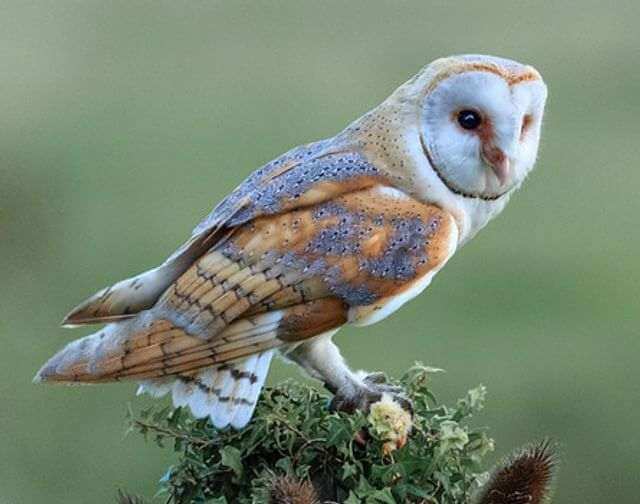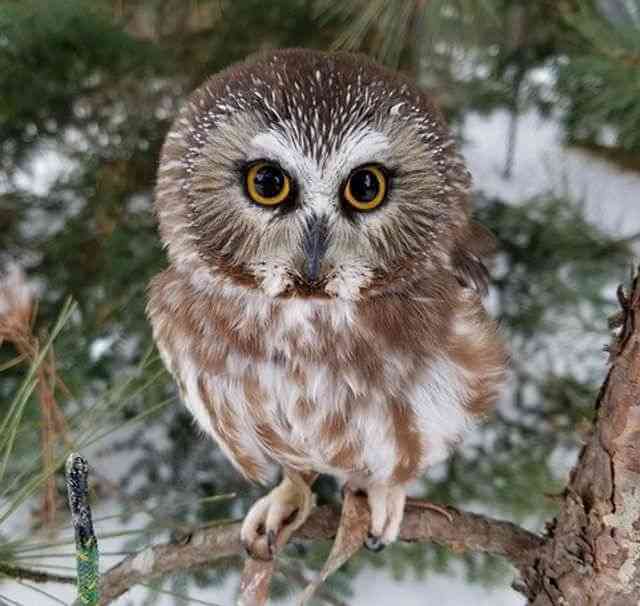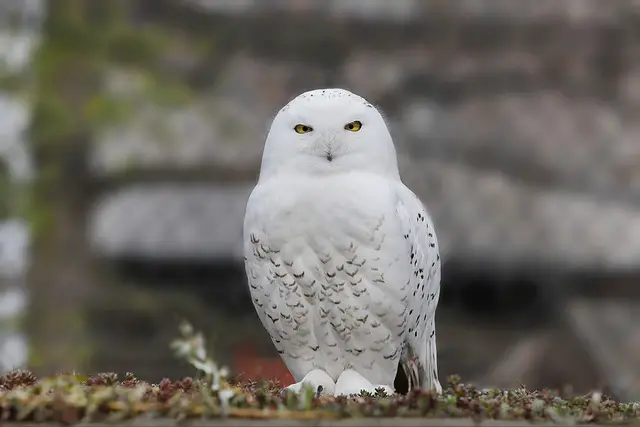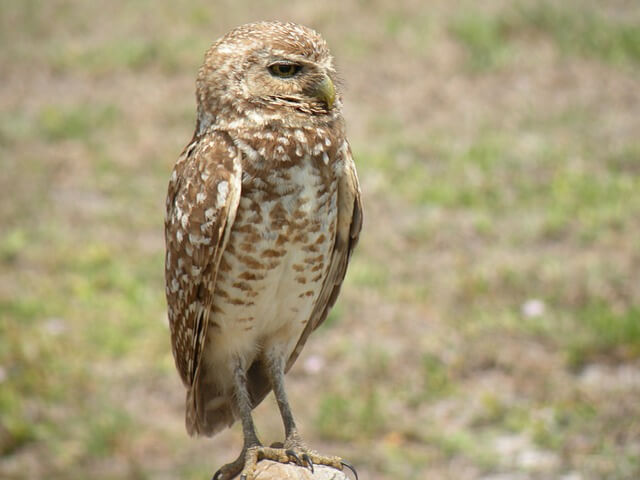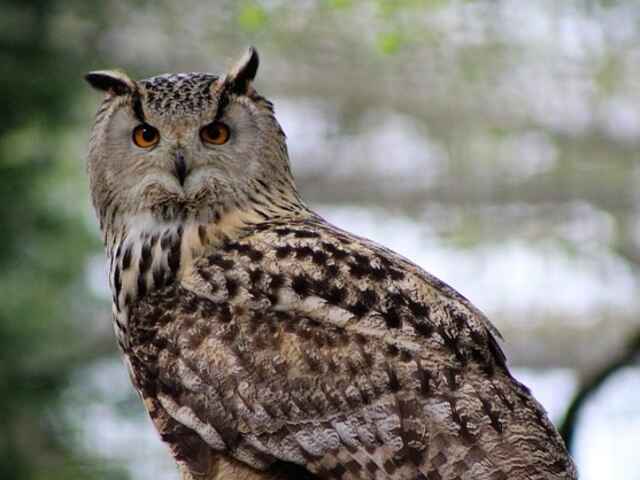Embark on a nocturnal adventure through Arkansas with our ultimate guide featuring 9 mesmerizing owl species! From the majestic Great Horned Owl to the elusive Eastern Screech Owl, Arkansas’s diverse landscapes provide a haven for these captivating nocturnal hunters.
In this comprehensive guide, we’ll uncover the unique characteristics, habitats, and behaviors of each owl species, offering valuable insights for bird enthusiasts and nature lovers.
Table of Contents
Types of Owls In Arkansas
Barred Owl
- Length: 16.9-19.7″ in (43-50 cm)
- Weight: 16.6-37.0 oz. (470-1050 g)
- Wingspan: 39.0-43.3″ in (99-110 cm)
- Scientific Name: Strix varia
- Frequency of Occurrence: 2.73% (Statistic by: eBird)
- Maps: Range Map – Sightings Map
- Sounds: Calls
- Where To Find Them: In Arkansas, they are most commonly found in the Ozark Mountains and Ouachita Mountains. They prefer forests with dense trees, but can also be found in swamps, riparian areas, and urban parks.
General Information: The Barred Owl is a large bird that can be found in North America. It has a round head with no ear tufts, and its eyes are dark brown. The upperparts of the Barred Owl are gray with brown bars, while the underparts are white with brown streaks. This owl gets its name from the barred pattern on its plumage.The Barred Owl has a large range, spanning from Canada to Mexico.
In Canada, it is found in all provinces except for Nunavut and Newfoundland. In the United States, it is found in all states except for Alaska and Hawaii. The Barred Owl prefers to live in forests, but can also be found in swamps, woodlands, and urban areas. The diet of the Barred Owl consists mostly of small mammals such as mice, voles, and squirrels.
Great Horned Owl
- Length: 17.7-24.8 in (45-63 cm)
- Weight: 32.1-88.2 oz. (910-2500 g)
- Wingspan: 39.8-57.1 in (101-145 cm)
- Scientific Name: Bubo virginianus
- Frequency of Occurrence: 1.50%
- Maps: Range Map – Sightings Map
- Sounds: Calls
- Where To Find Them: There are many Great Horned Owls located in Arkansas. Some of the most popular spots for these owls are in the Ozark Mountains.
General Information: The Great Horned Owl is a large owl with a prominent ear tufts. They can be found in North and South America. Its range includes most of Canada, the continental United States, Mexico, Central America, and much of South America. The Great Horned Owl is one of the most widespread owls in the Americas. The Great Horned Owl’s habitat is quite diverse, as it can be found in forests, woodlands, grasslands, and even deserts.
However, it typically prefers areas with trees for roosting and nesting. This owl is also known to nest in human-made structures such as buildings and bridges. Despite their large size, Great Horned Owls only eat small prey, such as mice and voles. They will also eat invertebrates, including amphibians and reptiles.
Related: 35 Fun Facts About The Great Horned Owl (Detailed)
Eastern Screech Owl
- Length: 6.3-9.8″ in (16-25 cm)
- Weight: 4.3-8.6 oz. (121-244 g)
- Wingspan: 18.9-24.0″ in (48-61 cm)
- Scientific Name: Megascops asio
- Frequency of Occurrence: 0.6270%
- Maps: Range Map – Sightings Map
- Sounds: Calls
- Where To Find Them: There are several places where you can find Eastern Screech Owls in Arkansas. One good place to look for them is the Buffalo National River area. This region has a variety of habitats that are perfect for these owls, including forests, cliffs, and hollow trees.
General Information: The Eastern Screech Owl is found in eastern North America, from southeastern Canada to northern Florida. Their preferred habitat is deciduous or mixed forests, but they can also be found in urban and suburban areas. Diet consists mostly of small mammals and birds, but they will also eat insects, reptiles, and amphibians.
Screech owls are relatively small owls, with a body length of 6-10 inches and a wingspan of 19-24 inches. They are brown or gray in color with subtle horizontal streaks on their breast. The owl’s head is large and round with yellow eyes and a black beak. When hunting, screech owls perch on a low branch or stump and watch for prey. They will also search for food by flying low over the ground or water.
Short-eared Owl
- Length: 13.4-16.9 in (34-43 cm)
- Weight: 7.3-16.8 oz. (206-475 g)
- Wingspan: 33.5-40.5 in (85-103 cm)
- Scientific Name: Asio flammeus
- Frequency of Occurrence: 0.1307%
- Maps: Range Map – Sightings Map
- Sounds: Calls
- Where To Find Them: In Arkansas, short-eared owls are found in the Ozark Mountains and the Arkansas River Valley. Short-eared owls hunt at any time of the day.
General Information: The short-eared owl is a fairly widespread bird, with a range that extends across most of North America, Europe, and Asia. Though its numbers have declined in recent years, it can still be found in a variety of habitats, from open grasslands to dense forests. This owl gets its name from its distinctive ear tufts, which are actually quite small.
It also has a large head and round body, which makes it look rather like a ball with wings! The short-eared owl is well adapted to hunting in open areas, where it can use its excellent eyesight and powerful talons to catch small mammals such as mice and voles. Though it will eat just about anything that moves, the short-eared owl has a particular fondness for meadow voles.
Barn Owl
- Length: 12.6-15.8″ in (32-40 cm)
- Weight: 14.1-24.7 oz. (400-700 g)
- Wingspan: 39.4-49.2″ in (100-125 cm)
- Scientific Name: Tyto alba
- Frequency of Occurrence: 0.1283%
- Maps: Range Map – Sightings Map
- Sounds: Calls
- Where To Find Them: One of the most popular places to find these owls is in Arkansas. There are many different barn owl hotspots in Arkansas, and one of the most popular ones is in the Ozark Mountains. This area is home to many different barn owls, and it is a great place to see them in their natural habitat. Another popular spot for barn owls in Arkansas is in the Arkansas River Valley. This area is home to many different species of birds, and it is a great place to see them up close.
General Information: Barn owl is a bird which can be found in many different regions of the world. Its range extends from Europe and Asia to North America and Africa. The barn owl is most commonly found in open habitats such as fields, meadows, and forests. The diet of the barn owl consists primarily of small mammals such as mice and voles.
The barn owl will also eat birds, reptiles, and insects on occasion. The barn owl hunts at night by using its excellent hearing to locate prey. The barn owl is a very important predator in many ecosystems. It helps to keep populations of small mammals in check which can help prevent damage to crops and spread of disease.
Northern Saw-whet Owl
- Length: 7.1-8.3 in (18-21 cm)
- Weight: 2.3-5.3 oz. (65-151 g)
- Wingspan: 16.5-18.9 in (42-48 cm)
- Scientific Name: Aegolius acadicus
- Frequency of Occurrence: 0.0404%
- Maps: Range Map – Sightings Map
- Sounds: Calls
- Where To Find Them: In Arkansas, they are most commonly found in the northern and central parts of the state. They prefer wooded areas with plenty of trees for roosting and nesting. Some common spots for finding them include the Ozark National Forest and Buffalo National River.
General Information: The Northern Saw-whet Owl is a small owl that makes its home in North America. This owl gets its name from its call, which sounds like the sharpening of a knife. The Northern Saw-whet Owl is a nocturnal bird, meaning it is active at night. The owl is also crepuscular, meaning it is most active at dawn and dusk.
The Northern Saw-whet Owl can be found in forests, woodlands, and even urban areas. The owl prefers to nest in trees, but will also nest in man-made structures like birdhouses. The diet of the Northern Saw-whet Owl consists of small mammals like mice and voles. The owl will also eat birds, insects, and reptiles.
Related: What is the Smallest Owl in North America? (A Full Guide)
Snowy Owl
- Length: 20.5-27.9 in (52-71 cm)
- Weight: 56.4-104.1 oz. (1600-2950 g)
- Wingspan: 49.6-57.1 in (126-145 cm)
- Scientific Name: Bubo scandiacus
- Frequency of Occurrence: 0.0132%
- Maps: Range Map – Sightings Map
- Sounds: Calls
- Where To Find Them: One of the best places to see a snowy owl in Arkansas is at Lake Maumelle. This large lake is a popular spot for birders, as it is home to a variety of different species. Snowy owls have been known to hunt around the edges of the lake, so keep your eyes peeled if you’re visiting this area. Another good place to see a snowy owl is at Beaver Lake. This lake is located in northwest Arkansas, and it is another great spot for birdwatching.
General Information: The Snowy Owl is a large owl of the typical owl family. The Snowy Owl (Bubo scandiacus) is found in Arctic regions in North America and Eurasia. These birds are mostly white in coloration with some dark barring on their wings and backs. The Snowy Owl’s round head is almost as wide as it is tall. Their yellow eyes are set off by a black beak. Female Snowy Owls are generally larger than the males of the species.
Snowy Owls live in open tundra and taiga habitats. They nest on the ground, building a scrape in the soil or snow. The female lays 3-11 eggs which hatch after 28-34 days. The young owls fledge at 50-60 days old, but remain dependent on their parents for several months longer. Snowy Owls primarily eat small rodents such as lemmings and voles.
Related: 48 Fun Facts About Snowy Owls (Full Guide with Photos!)
Burrowing Owl
- Length: 7.5-9.8″ in (19-25 cm)
- Weight: 5.3 oz. (150 g)
- Wingspan: 21.6″ in (55 cm)
- Scientific Name: Athene cunicularia
- Frequency of Occurrence: 0.0071%
- Maps: Range Map – Sightings Map
- Sounds: Calls
- Where To Find Them: There are several hot spots for Burrowing Owls in Arkansas. One of the most popular areas is in the Ozark Mountains near the Buffalo National River. Another good spot is near Lake Ouachita State Park. The third-best area for seeing these owls is around Sugar Loaf Mountain in central Arkansas.
General Information: The Burrowing Owl is a small owl found throughout North and South America. They get their name from their habit of living in burrows, which can be anything from abandoned gopher tunnels to man-made nest boxes. While most owls are nocturnal, Burrowing Owls are actually more active during the day. Burrowing Owls have a wide range, but are most commonly found in open grasslands or prairies.
They prefer areas with short vegetation, so they can have a clear view of their surroundings. Diet wise, these owls are opportunistic hunters and will eat whatever is available. Their main prey items include insects, rodents, and reptiles. While Burrowing Owls used to be fairly common, their populations have been declining in recent years due to habitat loss and persecution by humans.
Related: Really Cool Burrowing Owl Facts That Will Amaze You!
Long-eared Owl
- Length: 13.8-15.8 in (35-40 cm)
- Weight: 7.8-15.3 oz. (220-435 g)
- Wingspan: 35.4-39.4 in (90-100 cm)
- Scientific Name: Asio otus
- Frequency of Occurrence: 0.0038%
- Maps: Range Map – Sightings Map
- Sounds: Calls
- Where To Find Them: Long-eared owls are found in a variety of locations throughout Arkansas. They are most commonly found in wooded areas, but can also be found in open fields and meadows. Long-eared owls are relatively rare, but can be found in all parts of the state.
General Information: The long-eared owl is a medium-sized owl with ear tufts that are relatively long compared to other owls. They range in size from about 13 to 16 inches in length and have a wingspan just over 3 feet. These owls are found in wooded areas throughout North America, Europe, and Asia. They prefer to nest in trees, but will also use man-made structures such as nest boxes.
The diet of the long-eared owl consists primarily of small mammals such as mice, voles, and shrews. They will also consume birds, reptiles, and bugs. These owls hunt at night by perching on a branch and waiting for prey to come within range. They then use their sharp talons to swoop down and catch their prey.
Related Post:

